
Human
Organized by the University of California, Berkeley, The Magnes Collection of Jewish Art and Life
In Real Times Arthur Szyk: Artist and Soldier for
Rights 1926 1951
At Fairfield University, the exhibition is organized by Philip Eliasoph, PhD, Professor of Art History & Visual Culture. It is presented in partnership with the Bennett Center for Judaic Studies, Fairfield University, the Center for Jewish Heritage, New York, and the Jewish Federation of Greater Fairfield County. It is made possible thanks to generous sponsors, including Connecticut Humanities, Aquarion Water Company, Fiona Garland, the Maximilian E. & Marion O. Hoffman Foundation, John Meditz ’70, Rick & Debi Smilow on behalf of the Smilow Foundation, the Sy Syms Foundation, Terra Foundation for American Art, the Delamar Hotel, and Tadbik Inc. of Israel and NJ, and media sponsors WSHU, the Algemeiner, and Westport Journal, as well as community partners including the Pequot Library, New Canaan Historical Society, and the Fairfield Museum and History Center.
The acquisition of the Taube Family Arthur Szyk Collection (2017) and research for this exhibition were made possible by a generous gift from Taube Philanthropies.
UC Berkeley Exhibition Team
curators
Francesco Spagnolo and Shir Gal Kochavi faculty advisor Greg Niemeyer (Art Practice)
undergraduate curatorial assistants
Tamara Berkover, Isaac Engelberg, Shirin Sadjapour, Camille Thomas, Anna Tseselsky, Catherine Yang (UC Berkeley, URAP), Louis Polcin (Willamette University), Jesse Noily (Oberlin College)
visiting graduate curatorial assistant Jessica Rosenberg (Harvard Divinity School)
registrar
Julie Franklin exhibition specialist
Ernest Jolly
exhibition design
Gavin Lee, Azi Rad, Ellen Woodson, Gina Borg
Exhibition Resources
To read and download the digital catalog of this exhibition and to access additional resources about Arthur Szyk, please visit fairfield.edu/museum/szyk.
 The Magnes Collection of Jewish Art and Life University of California, Berkeley magnes.berkeley.edu
The Magnes Collection of Jewish Art and Life University of California, Berkeley magnes.berkeley.edu
Born into a middle-class Polish Jewish family, Arthur Szyk (Łódź, Poland, 1894 – New Canaan, Connecticut, 1951) lived a life framed by two world wars, the collapse of European democracies, and the rise of totalitarianism. A refugee, he ultimately settled in the United States in 1940. Throughout his work as a miniature artist and political caricaturist, he used motifs drawn from religion, history, politics, and culture, pairing extraordinary craftsmanship with searing commentary on a diverse range of subjects including Judaism, the American Revolution, the Second World War, the Holocaust, and the founding of the State of Israel.
Broad concerns for human rights are woven into Szyk’s entire production. In paintings and political cartoons, the artist exposed the Nazi genocide, supported the Polish resistance, exalted the establishment of the United Nations, and ridiculed dictators of all stripes. His unwavering denunciation of Fascist crimes in Europe, the suppression of national rights worldwide, and the endless violations of civil rights in America, are rooted in the experience of marginalization that characterized Jewish life in Eastern Europe in modern times. In our times, these concerns are still resounding strongly.
Szyk’s modular aesthetics are deeply connected with the political scope of his art. Medieval and Renaissance techniques, multilingual literary quotations, witty visual allegories, as well as modernist depictions of technology regularly recur in his works, and are often paired with enticing decorative themes that have made his oeuvre both popular and successful during, and well after, the span of the artist’s life.
This exhibition showcases over fifty original works of art from the Taube Family Arthur Szyk Collection, acquired by The Magnes in 2017. It also includes two workstations in the Walsh Gallery. Visitors can explore Szyk’s miniatures in high resolution, reconstructing the artist’s gaze through a “digital magnifying glass,” and are encouraged to remix and repurpose individual elements, characters, and motifs drawn from the Collection, and create new cartoons. This work is projected on large wall surfaces within the gallery itself, and can be instantly published online, giving the contemporary exploration and reinterpretation of Szyk’s art a broad audience “in real time.”
Francesco Spagnolo, curator of the exhibition
Human Rights, and their Collapse
In the 1920s, Arthur Szyk lived between his native Poland and France, where he was developing as an artist. At the same time, his gaze was already set beyond Europe.
Along with the publication of an illustrated version of The Statute of Kalisz (1928), a charter of Jewish liberties issued in Poland in the 13th century, he focused on the American Revolution, creating portraits devoted to its protagonists and key events. The series, titled Washington and His Times, was displayed at the Paris Colonial Exposition in 1931. Later, Szyk continued to return to this theme. In 1938 he created a new series, The Glorious Days of the Polish American Fraternity, commissioned by the Polish government for the New York World’s Fair. In his last years, he focused on Thomas Jefferson’s political legacy.
Overarching concerns about the dangers of tyranny, totalitarianism, and human rights violations often recur in Szyk’s entire opus, culminating in his highly publicized denunciations of the Holocaust. Soon after the news of Nazi massacres spread beyond Eastern Europe, the artist associated himself with a host of Jewish political activists and created new artwork supporting a demand for direct action from the Allied Forces, especially the US government.
2
London, 1938
Watercolor and gouache on paper | 2017.5.1.37
A Polish-Lithuanian military leader and national hero, Tadeusz Kościuszko (1746-1817) fought in the Continental Army during the American Revolutionary War (1775-1783). Szyk portrayed Kościuszko holding his will, addressed to Thomas Jefferson. In the document, Kościuszko authorized Jefferson to use his resources to give African-American slaves their “liberty in my name... teaching them to be defenders of their liberty and country, of the good order of society, and in whatsoever may make them happy and useful.”
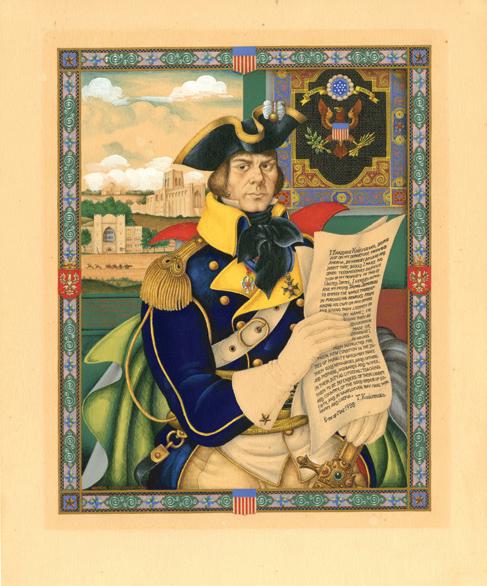
“Much of what we think of today as post-World War II international human rights began life as a specifically Jewish pursuit of minority rights in the ravaged borderlands of post-World War I Eastern Europe.”
3
James Loeffler, RootedCosmopolitans(2018)
₁. Tadeusz Kościuszko (The Glorious Days of the Polish American Fraternity)
“Friday, June 26 [1942] ... This morning, the English radio broadcast about the fate of Polish Jewry… For long months we had been suffering because the world was deaf and dumb to our unparalleled tragedy… But now it seems that all our interventions have finally achieved their purpose.”
Emmanuel Ringelblum,
New Canaan, Conn., 1951
Watercolor, gouache, ink, and colored pencil on board | 2017.5.1.224
In a letter to Benjamin Rush (September 3, 1800), Thomas Jefferson pronounced an unwavering oath against tyranny. In illustrating Jefferson’s words, Szyk allegorically connected them to the Korean War (1950-1953). At the bottom of the painting, an American soldier embodies a modern-day Saint George slaying a Korean dragon possessed by snakes.
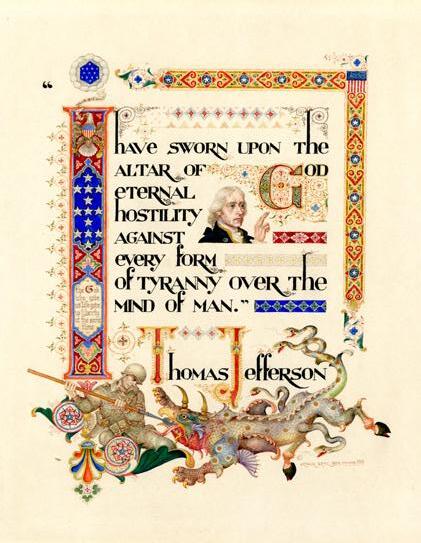
4
₂. Thomas Jefferson’s Oath
NotesfromtheWarsawGhetto(1958)
In the wake of news reporting the mass extermination of Jews in Eastern Europe (by BBC Radio in June of 1942, and by the Washington Post and other print outlets in November of the same year), Hollywood screenwriter Ben Hecht (1894-1964) wrote an article exposing Nazi crimes that was eventually excerpted in Readers’ Digest, thus reaching a wide readership. Hecht also co-authored We Will Never Die, a dramatic pageant staged as part of a sold-out rally that took place in Madison Square Garden (March 9, 1943), raising the awareness of Nazi crimes among Americans. The rally had been planned by the
“Committee for a Jewish Army of Stateless and Palestinian Jews,” one of several organizations created on behalf of the Revisionist Zionist movement by the activist Peter H. Bergson (born Hillel Kook, 1915-2001). Szyk created the cover art for the pageant, and also illustrated a poem by Hecht, titled Ballad of the Doomed Jews of Europe, for a Zionist magazine (The Answer, April 1943). Szyk’s illustrations dramatically depicted an emergency telephone call made from Europe to the United Nations going unanswered. The poem also appeared in The New York Times, in an ad purchased by Bergson’s Committee (September 1943).

5
New York, March 1943 Ink and graphite on board | 2017.5.1.110
₃. Ballad of the Doomed Jews of Europe [by Ben Hecht (1894-1964)]
₄.
De Profundis. Cain, Where is Abel Thy Brother?
New York, 1943 Ink and graphite on board | 2017.5.1.109
A visual meditation on the massacre of Jews during the Second World War, featuring motifs drawn from classical Jewish and Christian texts. The Latin title, De Profundis (“out of the depths,” Ps. 130), written at the top, is followed by a question in English: “Cain, where is Abel thy brother?” (Genesis 4:9). Within the words of the title are visual and textual quotations from both the Hebrew Bible and the Gospels. Jewish victims are depicted as piles of bodies, which prominently feature Jesus holding the Tablets listing the Ten Commandments in Hebrew, and men, women, and children dressed in both secular and religious garments. The drawing was first published in the Chicago Sun in February of 1943.

6
The Rights of Global Refugees
The start of the Second World War coincided with the partition of Poland between Nazi Germany and the Soviet Union. This, along with subsequent invasions of European territories by the German army, turned many into refugees, including Arthur Szyk himself and his immediate family. Running for their lives, scores of individuals and families found themselves victims of the lack of legal status granted by nationhood. Szyk depicted the plight of refugees in many different contexts, from the illustration of biblical narratives (the Book of Ruth) to the portrayal of citizens of Poland and veterans of its disbanded army, and of Jews, adults and children alike. At the end of the war, he continued to denounce the loss of human rights experienced by refugees, and the system of quotas regulating the entry of Jewish Holocaust survivors into the United States and British Mandatory Palestine.
Hannah Arendt, “We Refugees” (MenorahJournal, January 1943)
7
“Contemporary history has created a new kind of human beings—the kind that are put in concentration camps by their foes and in internment camps by their friends.”
London, 1940
Watercolor and gouache on paper | 2017.5.1.48
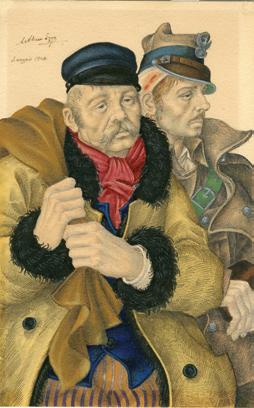
New York, 1945
Watercolor and ink on paper | 2017.5.1.151
Costume designed for an unidentified play featuring the Lithuanian Jewish dancer and performer Bella Reine (1897-1983), active in France since the 1920s and a refugee in New York City during the Second World War. Rather than an exotic travel destination, the suitcase held by the actress is labeled “Vittel,” in reference to an internment camp for enemy aliens, including Jews, established in north-east France in 1941 by the German occupying forces.
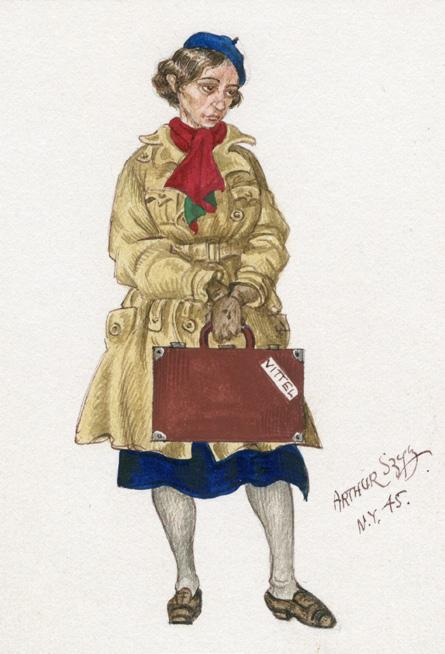
8
₁. Untitled [Polish Soldier and Peasant]
₂. Bella Reine. Premier & dernier costume (Bella Reine. First and Last Costume)
₃. To Be Shot, as Dangerous Enemies of the Third Reich!
New York, 1943
Ink and graphite on paper | 2017.5.1.114
₄. (The Jewish Plot to Survive) “I just tell the Americans that they are communists, and to the Russians that they are fascists...”


New Canaan, Conn., 1948
Watercolor, gouache, ink, and graphite on board
2017.5.1.196
9 9
₁. “And the name of the man was Elimelech, and the name of his wife Naomi, and the name of his two sons Mahlon & Chilion” Ruth. Chapter I
New Canaan, Conn., 1946
Watercolor and gouache on board | 2017.5.1.177
₂. Untitled [Three Jewish children]

New York, 1944
Ink and graphite on paper | 2017.5.1.128
3. Emergency Committee to Save The Jewish People of Europe (1943-1945)
Save Human Lives [Stamps booklet]
New York, 1944 (8 stamp pages, 11 leaves in total)
Offset Lithograph on paper with gum arabic adhesive
Arthur Szyk papers, photographs and memorabilia, 2017.5 AR1
Arthur Szyk papers, photographs and memorabilia, 2017.5 AR1
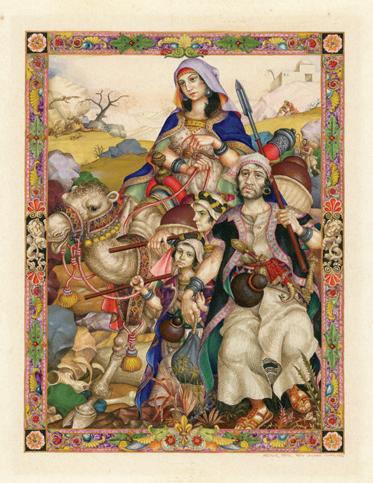
10
CASE 1
₄. Untitled [“Love for Man and Nature has been My Guide”]
Ottawa, 1940
Watercolor and gouache on paper
2017.5.1.50
In 1940, Szyk and his family reached Canada as refugees. Later that year, they settled in the United States. The artist composed an ode to Canada and its peoples, acknowledging their role in the war effort. Among the characters in the painting,

Szyk added himself, wearing a military uniform and holding an artist’s palette and brushes.
₅. Untitled [Portrait of Julia Likerman Szyk, Wife of the Artist]
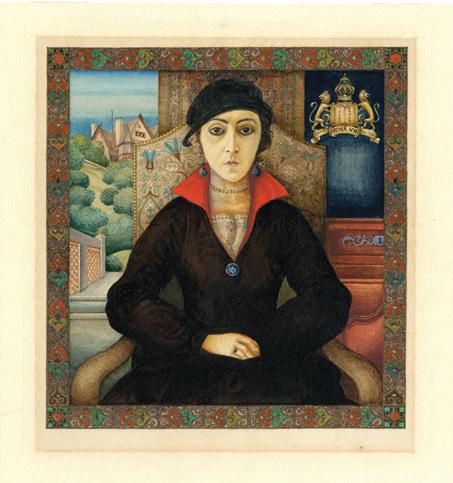
Paris, 1926
Watercolor, gouache, and graphite on paper | 2017.5.1.25
11
The Right to Resist
The Warsaw Ghetto uprising broke out on April 19, and continued until May 16, 1943, when the German troops left the ghetto in ruins and deported the last survivors. Jewish resistance organizations involved in the uprising spanned the entire spectrum of political activism in the ghetto. They included the leftwing Zionist Jewish Combat Organization (Zydowska Organizacja Bojowa, or ZOB) and the Jewish Military Union (Zydowski Zwiazek Wojskowy, or ZZW), which was led by members of Betar, the youth group of the Revisionist Zionist movement, with logistical support provided by the Home Army (Armia Krajowa, or AK), one of the national resistance groups established in Poland in 1940. In his depictions of the uprising, Arthur Szyk portrayed some of its military leaders, including Mordecai Anielewicz (1919-1943; ZOB) and Dawid Wdowiński (1895-1970; ZZW).
“On April 19th, 1943, at 2 am, the first messages concerning the Germans’ approach arrived from outermost observation posts... At 7 o’clock... the SS-men... marched into the seemingly dead streets of the central ghetto. Their triumph appeared to be complete… But no, they did not scare us and we were not taken by surprise.”
Marek Edelman, “The Ghetto Fights” (ca. 1988)
12 12
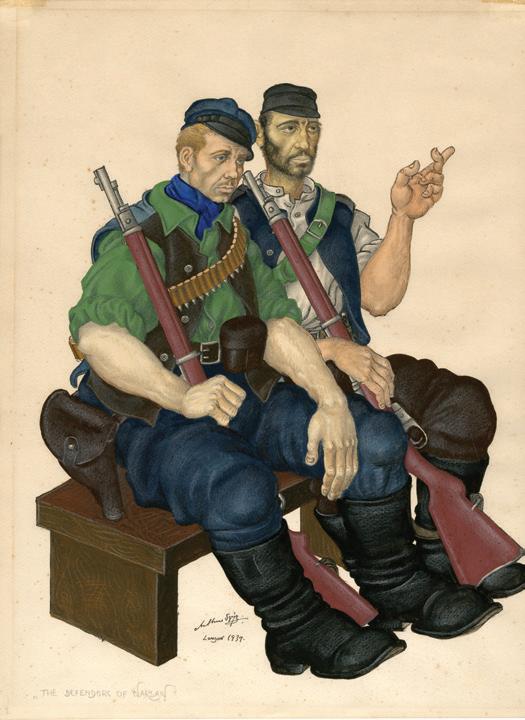
13
₁. Defenders of Warsaw
London, 1939 Watercolor, gouache, ink, and graphite on paper 2017.5.1.45
New York, 1942
Watercolor and gouache on board | 2017.5.1.99
King Władysław II Jagiełło (ca. 1352-1434), who ruled Poland between 1386-1434, belonged to the Jagiellonian dynasty that ruled over Poland and Lithuania until 1572, and initiated the Polish-Lithuanian Commonwealth. Szyk painted a portrait of the King for the series, “Brotherhood in Arms,” dedicated to the Polish nation. By portraying Jagiełło in 1943, Szyk allegorically pointed to the role of the Polish-Lithuanian union (14th-18th centuries) in resisting the Teutonic invasions as an inspiration for the contemporary Polish resistance against German influence. The King’s shield is inscribed in Polish with a quote from The Oath, a poem written in 1908 by Polish independence activist Maria Konopnicka (1842-1910) against the policies of the German Empire: “We shall not forsake the land we came from. We shall not let our speech be buried. We are the Polish nation, the Polish people. From the royal line of Piast.” At the King’s feet, an axe crushes a Nazi swastika, inscribed with the words “The people’s revenge, you will not escape!!!” In the background, Polish soldiers, embedded with the French and British Allied troops, are depicted going to war against Nazi Germany.

14
₂. Narodowi Polskiemu, w Braterstwie Broni Naród Amerykański (The Polish Nation, the Brotherhood of American Arms) [King Władysław II Jagiełło (ca. 1352-1434)]
₁. To the Gallant Poles, in Comradeship of Arms, The People of America


New York, 1942
Ink and graphite on paper | 2017.5.1.83
₂. The Repulsed Attack (from “The Songs of the Ghetto”)
New York, 1943
Ink and graphite on board | 2017.5.1.113
15
CASE 2
₃. My People. Samson in the Ghetto
(The Battle of the Warsaw Ghetto)
New York, 1945
Watercolor, gouache, ink, and graphite on board
2017.5.1.129
4 Statut de Kalisz
(The Statute of Kalisz)
Munich, F. Bruckman, 1932 Offset Lithograph on hot press paper 2017.5.2.65
5 World Alliance for Combating Anti-Semitism Catalogue.
Exhibition Held at the Bishopsgate Institute of the Polish Charter of Freedom Granted to the Jewish People.
Illuminated by the Eminent Jewish Painter Arthur Szyk
London, July 1933 Offset lithograph Arthur Szyk papers, photographs and memorabilia, 2017.5 AR1

16
CASE 2
The Rights of Nationhood
In his oeuvre, Arthur Szyk actively sought to celebrate nationhood as a means to securing human rights. In this, he appeared to have internalized the understanding, emblematically expressed by political thinker Hannah Arendt (1906-1975), that individual human beings could enjoy the “right to have rights” only through the membership in a political community, which, in the modern era, was solely represented by nation-states. Szyk’s works include stamp designs, illustrated Declarations of Independence, national charters, and designs for the “corporate identity” of national organizations ranging from military units to art institutions.
17
“Not only did loss of national rights in all instances entail the loss of human rights; the restoration of human rights, as the recent example of the State of Israel proves, has been achieved so far only through the restoration or the establishment of national rights.”
Hannah Arendt, TheOriginsofTotalitarianism(1951)
Heritage of the Nations
Kasimir Bileski, a Canadian stamp dealer, commissioned Arthur Szyk in 1945 to create Heritage of the Nations, a series of new stamp designs celebrating the members of the newly established United Nations and its Security Council. Between 1945 and 1951, Szyk created stamps representing France, Great Britain, Switzerland, Poland, Canada, the United States, the USSR, Israel, China, Newfoundland, and Nova Scotia. These highly allegorical representations combine historical and present-day references and symbols. The project remained incomplete due to the artist’s death in 1951. Bileski continued to promote and reproduce these works in his philatelist newsletter until the 1990s.
₁. Poland (Heritage of the Nations series)
New Canaan, Conn., 1946
Watercolor and gouache, pen and ink and pencil on board | 2017.5.1.182
₂. France (Heritage of the Nations series)
New Canaan, Conn., 1947
Watercolor and gouache, pen and ink and pencil on board | 2017.5.1.186
₃. United Kingdom. (Heritage of the Nations series)
New Canaan, Conn., 1947
Watercolor and gouache, ink and graphite on board | 2017.5.1.185
18



19
₄. Pacte de la Société des Nations avec Annexe (Covenant of the League of Nations, with Annex)

Paris, 1931
Watercolor, gouache, ink and gold illumination on paper 2017.5.1.34
In 1931, Arthur Szyk illustrated the title page of the Covenant of the League of Nations, a worldwide intergovernmental organization established at the end of the First World War with the goal of preventing conflict among sovereign states. The illustrations divide the page in two sections. At the top, life and peace are granted to refugees, shown gazing at the headquarters of the League in Geneva, next to a self-portrait of the artist as a “sign painter.” The lower sections depict scenes of war, destruction, and reconstruction, including themes drawn from the Christian tradition, such as Saint George (or the archangel Michael) slaying a dragon and a memento mori.
20
₅. Canada. (Heritage of the Nations series)
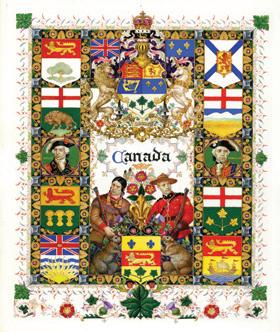
New Canaan, Conn., 1946
Watercolor and gouache, ink and graphite on board
2017.5.1.181
₆. The United States of America. (Heritage of the Nations series)

New York, 1945
Watercolor and gouache, pen and ink and pencil on board
2017.5.1.180
₇. Israel. (Heritage of the Nations series)

New Canaan, Conn., 1948
Watercolor and gouache, pen and ink and pencil on board
2017.5.1.189
21
Icons of Nationhood
Emblems, heraldry, and the design of “corporate identity” for organizations and countries are an important component of Arthur Szyk’s work as an illustrator. Many of the designs he created eventually became letterheads, stamps, and logos, and were also featured in his artwork. His illustrations for Poland focused on support for Polish soldiers fighting in various independence movements; those created for Israel aimed at shaping the public image of the nascent State.


Watercolor and gouache on paper
2017.5.1.161
Watercolor and gouache on paper
2017.5.1.158a
22
CASE 2
₁. Za naszą i waszą wolność. (For Our Freedom and Yours)
₂. Legion Kośiuszkowski. Kościuszko Legion
Poland
Israel
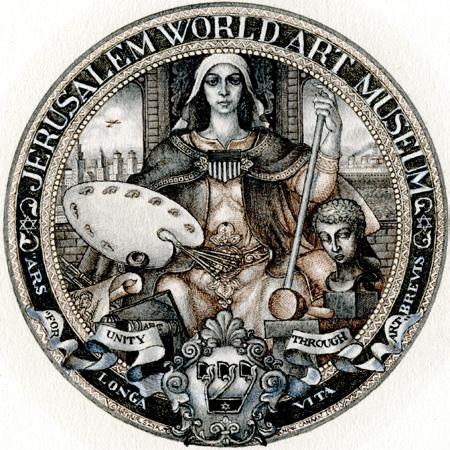

₃. Zachor (Remember). Stamps of Israel (Memorial Stamp – Europe) First Day Cover 4
United States, late 1940s Ink on paper | 2017.5.1.198
New Canaan, 1949
Ink on paper | 2017.5.1.213
23
₄. Jerusalem World Art Museum
The Right to Expose: Tyrants “at Work”
Many of Arthur Szyk’s political cartoons were devoted to exposing the crimes of Adolf Hitler, his associates, and their allies. Created to achieve a great impact through the printing press in Europe and the United States, these drawings display a harrowing tension between tragedy and farce. Individuals are often portrayed with emphasized facial and bodily traits, and groups are carefully choreographed to expose inner power dynamics, political proclivities, and petty idiosyncrasies. To the historian, these portraits point to specific events in the development of the Third Reich, and the long-range effects of its crimes. To the general public, they offer a gallery of historical characters portrayed with a blend of intimacy and satire.
Adolf Hitler is the undisputed archvillain of Szyk’s pictorial imagination. Just as Charlie Chaplin created a new character named Adenoid Hynkel (the dictator of “Tomania” in the 1940 movie, The Great Dictator), Szyk often referred to the tyrant with the ironic name of Schicklgruber, the surname of Hitler’s illegitimately-born father, Alois. At the same time, most of Szyk’s works are also layered with nuanced aesthetic and political messages. They include sophisticated references to Nazi ideology (such as its repurposing of the German nationalist concept of Lebensraum, or “living space,” and of Wagnerian myths), to the inner politics of European Fascist regimes, and to their global impact, from North Africa to Latin America.
24
₁. Polsce, Chrystusowi Narodow (Poland, the Christ of Nations). [Adolf Hitler, 1889-1945]
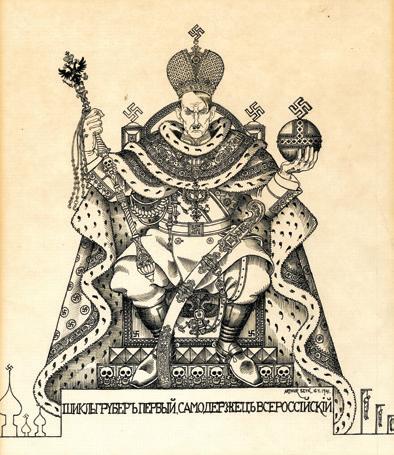
London, 1939
Watercolor, gouache, colored pencil, and ink on paper | 2017.5.1.47
₂. Schiklgruber. Perviy Samoderzhets Vserosiskiy. (Schicklgruber I, TsarAutocrat of All Russia). [Adolf Hitler, 1889-1945]
New York, 1941
Ink and graphite on paper | 2017.5.1.67
Published for The American Mercury, a magazine published monthly in New York City, this cartoon refers to “Operation Barbarossa,” the Axis invasion of the Soviet Union that began in June of 1941.
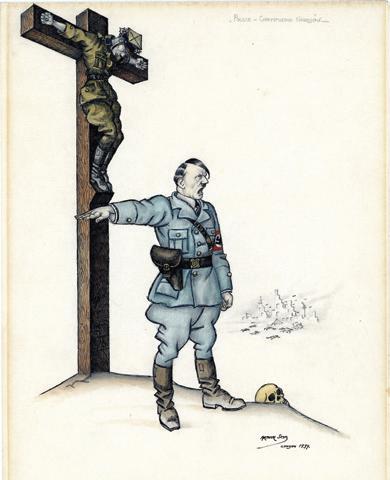
25
Charlie Chaplin, MyAutobiography(1964)
₃. “I Don’t Wont [sic] To Be Misunderstood, But I Invest My Money In U.S. War Bonds...” [Hermann Göring, 1893-1946]
New York, 1942
Ink and graphite on paper | 2017.5.1.92
Hermann Göring (18931946), a decorated veteran fighter pilot in the First World War, was one of the most prominent leaders of the Nazi party in Germany. He created the Gestapo (Nazi Germany’s secret police), was the commander in chief of the German airforce, and led the Four Year Plan that supported the Nazi war economy. After being sentenced to death in the Nuremberg trials, he committed suicide.
₄. Benito the Terrific. [Benito Mussolini, 1883-1945]
New York, 1942 Ink and graphite on paper | 2017.5.1.82
A satirical depiction of Italian dictator Benito Mussolini (1883-1945), dedicated to Virginio Gayda (1885-1944), a journalist and heterodox supporter of Fascism, an anti-Semite, and a vocal critic of Italy’s involvement in the Second World War.

26
“Half-way through making
The Great Dictator I began receiving alarming messages… that I would run into censorship trouble... But I was determined to go ahead, for Hitler must be laughed at.”
₅. Notre “Ami Pierrot” (Ma chandelle est morte, je n’ai plus de feu...) (Our “Friend Pierrot.” My Candle is Dead, I Have No More Fire...). [Philippe Pétain, 1856-1951]
New York, 1941
Ink and gouache on board | 2017.5.1.59
Portrait of Philippe Pétain (1856-1951), Chief of State of the Nazi collaborationist government of Vichy France, as a modern version of the comedic character and sad clown Pierrot, quoting the famous French 18th-century folk song, Au clair de la lune.


27



28
6
“Lebensraum”... Le Future de l’Europe tel qu’ils le voient… (“Living Space”... The Future of Europe as They See It). [Adolf Hitler, 1889-1945, and Joseph Stalin, 1878-1953]
London, 1939
Watercolor, gouache, ink, and graphite on paper 2017.5.1.43
Exhibited at the Fine Art Society, London (January, 1940).
7 The Silent Partner. “In this game, Adolph [sic], two aces is more than three kings.”
New York, September 1941
Watercolor, gouache, ink, and pencil on paper 2017.5.1.69
Cartoon published on the cover of Collier’s, depicting a poker game played by Adolf Hitler (1889-1945), a soldier wearing a Red Army uniform, and a skeleton dressed in a German general’s uniform. Hitler is holding three Kings (each depicting Benito Mussolini/Italy, Philippe Pétain/France, and Hirohito/ Japan), while his opponent holds two Aces (representing the United States and the United Kingdom). Seven puppets are tied to Hitler’s pants, representing Miklós Horthy (1868-1957, Hungary), Carl Mannerheim (1867-1951, Finland), Hirohito (1901-1989, Japan), Benito Mussolini (1883-1945, Italy), Philippe Pétain (1856-1951, Vichy France), and Francisco Franco (1892-1975, Spain).
New York, September 1941
Watercolor, gouache, ink, and graphite on paper
2017.5.1.70
In this cartoon, published on the cover of Collier’s, Nazi leaders Adolf Hitler (1889-1945), Hermann Göring (1893-1946), Heinrich Himmler (1900-1945) and Joseph Goebbels (18971945) stand together, pinning Nazi flags on a globe threatened by a Nazi rattlesnake. At their feet lay collaborators Philippe Pétain (1856-1951) and Benito Mussolini (1883-1945). The scene is complemented by literary quotations ranging from Dante’s Inferno to a German folk song that became the anthem of the Hitler Youth movement.
29
8. Madness
“Had I known of the actual horrors of the German concentration camps, I could not have made The Great Dictator, I could not have made fun of the homicidal insanity of the Nazis.”
Charlie Chaplin, MyAutobiography(1964)
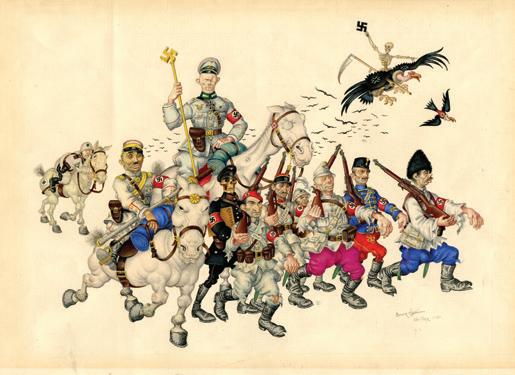

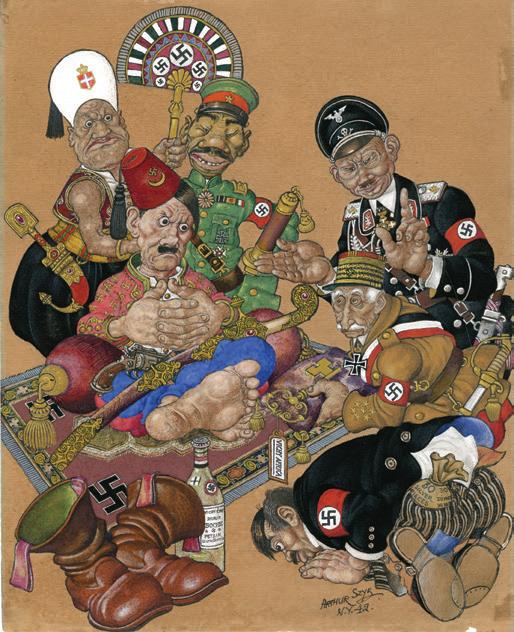
30
New York, 1941
Watercolor and gouache on paper | 2017.5.1.57
In this cartoon, published in Esquire in 1942, Nazi leader Heinrich Himmler (1900-1945) is portrayed along with an army made of representatives of the Axis powers and their collaborators. From left to right: Italy (Benito Mussolini, 18831945), Japan (Hirohito, 1901-1989), Spain (possibly Sancho Dávila, 1905-1972), Vichy France (Philippe Pétain, 1856-1951), Belgium (Léon Degrelle, 1906-1994), Finland (possibly Simo Häyhä, 1895-2002), Hungary, and Romania.
10 Walhalla G.m.b.H. (The Niebelungen, Valhalla). (Valhalla, Inc.)
New York, 1942
Ink and graphite on paper | 2017.5.1.93
Inspired by the opera series The Ring of the Nibelung, by Richard Wagner (1813-1883), this cartoon originally appeared in Cosmopolitan in 1943. The scene, presented as a banquet hosted by Wotan, the King of the Gods in Wagner’s mythology, features historical figures who both preceded and animated the Nazi regime. Among those seated at the table are the Prussian statesman Otto Von Bismarck (1815-1898), and Wilhelm II (1859-1941), the last German Emperor. Nazi leaders Adolf Hitler (1889-1945), Hermann Göring (1893-1946), and Joseph Goebbels (1897-1945) act as waiters, assisted by Italian dictator Benito Mussolini (1883-1945), while the French collaborationist Philippe Pétain (1856-1951) is in the kitchen. Skulls, and a copy of a book by Jewish writer Heinrich Heine (1797-1856) are on the floor, along with a Jewish man turned into a bear-skin rug, while the new literary “classics” of Nazi culture (Hitler’s Mein Kampf, the Protocols of the Elders of Zion, Arthur de Gobineau’s An Essay on the Inequality of the Human Races, and others) are on a bookshelf next to the dining table. The “soundtrack” at the bottom features Leitmotiven (recurrent musical themes) drawn from Wagner’s works.
11. The Key to French Africa
New York, 1942
Watercolor and gouache on paper | 2017.5.1.98
A cartoon providing political commentary on the role of European Fascist powers in North Africa, published in Szyk’s anthology, Ink and Blood (1946). It features Adolf Hitler (18891945), surrounded by Benito Mussolini (1883-1945), Japan’s Prime Minister Hideki Tojo (1884-1948), Heinrich Himmler (1900-1945), and Vichy France’s Philippe Pétain (1856-1951) and Pierre Laval (1883-1945).
31 9. The New Orderlies
12 Libertad (Freedom)
New York, 1944
Ink and graphite on paper | 2017.5.1.126b
In the 1930s, Szyk conceived a series of drawings celebrating Latin American independence leader Simón Bolívar (17831830) entitled The Epic of Simon Bolivar. In 1944 in a cartoon published in the dailies PM (New York) and El Nacional (Caracas, Venezuela), Szyk depicted Bolivar’s legacy under the threat of European and Latin American Fascist dictators, including Adolf Hitler (1889-1945), Francisco Franco (18921975), and Argentinian Presidents Pedro Pablo Ramírez (1884-1962) and Juan Perón (1895-1974).

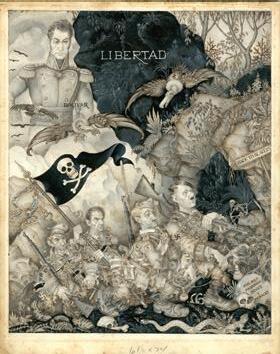
13 “I Need Peace Now!! I must prepare for the third round...”
New York, 1944
Watercolor and gouache on paper | 2017.5.1.121
Germania, a 19th-century personification of the German nation, is seated in frustration as Nazi war plans appear to go awry at the hands of Adolf Hitler (1889-1945) and his associates Joseph Goebbels (1897-1945), Hermann Göring (1893-1946), and Heinrich Himmler (1900-1945).
32
₁. Goeringo Il Magnifico (Göring the Magnificent). [Hermann Göring, 1893-1946]
New York, 1941
Watercolor, gouache, and ink on paper | 2017.5.1.75
2. We’re running short of Jews. [Adolf Hitler, 1889-1945, Heinrich Himmler, 1900-1945, Hermann Göring, 1893-1946, and Joseph Goebbels, 1897-1945]
One of Szyk’s many works denouncing the Nazi genocidal project (in 1943, the victim count was estimated at two million) was dedicated to the tragic loss of the artist’s mother: “To the memory of my darling mother murdered by the Germans somewhere in the Ghettos of Poland.” A later work (Pathways to the Bible, 1946), was again dedicated to Szyk’s mother, this time listing the extermination camp of Majdanek as her place of death.


New York, 1943
Ink and graphite on paper | 2017.5.1.115
3. Untitled. [Adolf Hitler (1889-1945), conducting a choir of international Axis leaders]
New York, 1940s
Graphite on paper 2017.5.1.247
33 CASE 3
₄. (The Modern Hamlet) Aryan or Non AryanThat is the question. [Joseph Goebbels, 1897-1945]
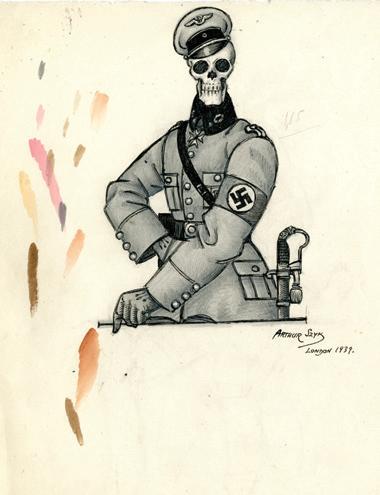

New York, 1941
Ink and graphite on paper | 2017.5.1.64
₅. The German “Authority” in Poland
London, 1939
Ink and graphite on paper | 2017.5.1.41
34
₆a. The Silent Partner.
“In this game, Adolph [sic], Two Aces is More Than Three Kings.”
Collier’s (front cover)
New York, November 1, 1941
Offset lithograph
2017.5.4.2
₆b From Arthur Szyk [Letter to Collier’s readers]

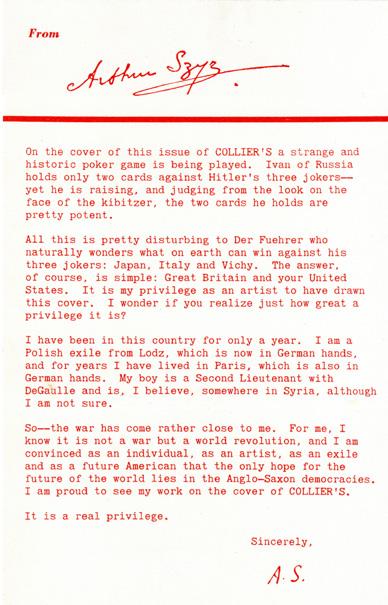
Collier’s, New York, November 1, 1941
Offset lithograph
Arthur Szyk papers, photographs and memorabilia
2017.5 AR1
35
The Right to America
Political cartoons created by Arthur Szyk during the Second World War often took aim at the “racial theories” of the Third Reich. The artist highlighted the multi-ethnic fabric of the US Army, positioning it in direct contrast to Nazi Aryan supremacy. Szyk displayed a similar uncompromising attitude towards the politics of race in America, taking aim at the Ku Klux Klan and the legacy of slavery. During the last years of his life, he also created stamp designs for the Republic of Liberia, a country founded in mid19th-century through the efforts of the Society for the Colonization of Free People of Color of America.

₁. Untitled. [Poster design for the New York State’s Committee on Discrimination in Employment]
New York, 1943 Ink and graphite on board | 2017.5.1.108
₂. Racial Humiliation
New York, 1944 Ink and graphite on paper | 2017.5.1.127
36

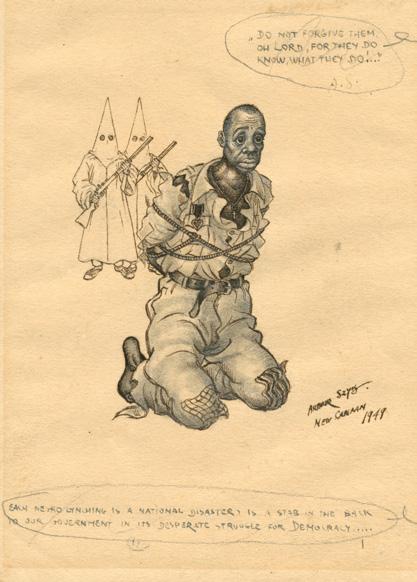
₃. Do not forgive them, oh Lord, for they do know, what they do! [after Luke 23:34] New Canaan, Conn., 1949 Ink and graphite on paper | 2017.5.1.214 Published in the Sunday Compass (New York). 37
₄. Untitled. [Floral border for “The Case for the Minorities,” by Wendell Willkie]

New York, ca. 1942 Ink and graphite on paper | 2017.5.1.304
Wendell Willkie (1892-1944) was a lawyer, an opponent of the Ku Klux Klan, and the 1940 Republican nominee for President. Willkie’s text was originally published under the title “The Case for the Minorities” in The Saturday Evening Post (1942), in response to a widely criticized article by Milton Mayer (“The Case Against the Jews”).
38
For the Republic of Liberia
In 1950, Franklin R. Bruns (1912-1979), a philatelic adviser and curator at the Smithsonian Institute, commissioned the design of a series of stamps for the Republic of Liberia from Arthur Szyk. The project was completed after Szyk’s death in 1951. Several of Szyk’s works explicitly reference the involvement of Jehudi Ashmun (1794-1828), a religious leader from New York, in the founding of the colony of Liberia (1822). Ashman was a member of The Society of the Colonization of Free People of Color of America (established in 1816 to support the migration of free African Americans to Africa). Between the years 1822-1828 he served as governor of the Republic of Liberia on behalf of the United States.
1. Republic of Liberia (souvenir sheet) New Canaan, Conn., 1950 Ink and graphite on paper | 2017.5.1.217a
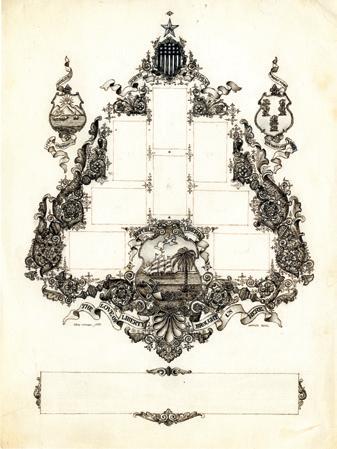
39
CASE 3
Liberia Souvenir


New Canaan, Conn., 1950
Watercolor, gouache, and graphite on board | 2017.5.6.5.1
New Canaan, Conn., 1950
Watercolor, gouache, and graphite on board | 2017.5.1.216
40
2. Harry L. Peckmore & Son (Engravers)
Sheet with Eight Republic of Liberia Stamp
3. Republic of Liberia (Air mail postal stamp)
Arthur Szyk (1894-1951)


Untitled. [Self-portrait, drawing an anti-Nazi cartoon]
New York, 1941 | Ink on paper
Taube Family Arthur Szyk Collection, 2017.5.1.412
Roman Vishniac (1897-1990)
The miniature painter, Arthur Szyk
New York, 1942 | Inkjet print from original negative Gift of Mara Vishniac Kohn, 2017.12.2
Major funding for The Magnes Collection comes from Karen and Franklin Dabby, the Walter & Elise Haas Fund, the Helzel Family Foundation, the Koret Foundation, Peachy and Mark (z”l) Levy, the Magnes Leadership Circle, the Magnes Museum Foundation, the Office of the Chancellor at the University of California, Berkeley, Barbro and Bernard Osher, and Taube Philanthropies.
Additional research was supported, in part, by the Undergraduate Research Apprentice Program (URAP) of the University of California, Berkeley. The Curators also extend their gratitude to the scholars who participated in the program, Around Arthur Szyk, held at The Magnes in 2018-2019: Professors Deena Aranoff (Center for Jewish Studies, Graduate Theological Union), John Connelly (History, UC Berkeley), and Isabel Richter (DAAD Professor, German and History, UC Berkeley).
41
68

 The Magnes Collection of Jewish Art and Life University of California, Berkeley magnes.berkeley.edu
The Magnes Collection of Jewish Art and Life University of California, Berkeley magnes.berkeley.edu
























































